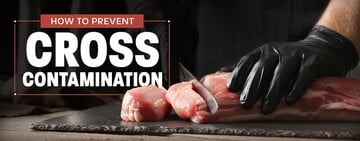
The right cutting boards are an indispensable tool in any commercial kitchen. They're used to chop vegetables, fruits, and meats, making meal preparation more efficient. However, not all cutting boards are created equal. The two most popular types of cutting boards are plastic and wooden cutting boards. While both serve the same purpose, they have different properties and require different care. Properly caring for cutting boards not only increases their lifespan but also prevents bacteria from spreading and causing dangerous cross-contamination. Keep reading to learn how to clean your cutting board correctly.
Shop All Cutting BoardsWooden vs Plastic Cutting Board
When choosing the right cutting board for your kitchen, it is important to understand their differences. Plastic cutting boards are lightweight, dishwasher safe, and easy to clean. They're also less expensive than wooden cutting boards and have a typical lifespan of 1-5 years. However, they can be more prone to knife marks, which can harbor bacteria.
Compared to plastic cutting boards, wooden cutting boards are more durable and less prone to knife marks, helping you preserve your blade's sharpness. They also have antimicrobial properties and last about 5-10 years. However, wood cutting boards are naturally porous, meaning they can't be put in the dishwasher, making them harder to thoroughly clean. It is for this reason that wooden cutting boards are illegal for commercial use in New York City.
How to Clean a Plastic Cutting Board

Plastic cutting boards are the most common type of cutting board used in the foodservice industry. Because they can be easily scratched and scored, it's important to clean them properly to kill any bacteria trapped in the deep grooves. Most plastic cutting boards are designed to be dishwasher safe, but repeated exposure to high temperatures may cause warping.
How to Clean Plastic Cutting Board with Bleach
Use the following method for cleaning plastic cutting boards with bleach:
- Mix cleaning solution: Create a sanitizing solution of 1 tsp. of bleach to 1 quart of water.
- Wipe the board: Once the cleaning solution has been mixed, wipe the surface of your plastic cutting boards down with the cleaning solution.
- Rinse: Once the board has had time to sit for a few minutes, rinse it with water and let it air dry.
How to Clean Plastic Cutting Boards With Vinegar
If you are wary of using bleach on your cutting boards, vinegar can be used as a substitute.
- Create paste: Mix equal amounts of baking soda and vinegar into a paste-like substance.
- Apply to board: Once the paste has been mixed, spread it over the cutting board and let it sit.
- Rinse: After five minutes, wash the board with soap and water and rinse.
How to Clean a White Cutting Board
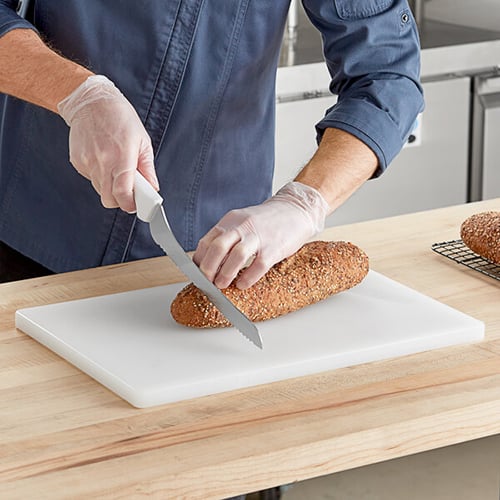
Try the following solution if your white cutting board is still stained after cleaning with bleach or vinegar:
- Create paste: Add 1 teaspoon of baking soda, 1 teaspoon of salt, and 1 teaspoon of water to make a paste.
- Apply to board: Spread the paste over the stained areas.
- Rinse: After five minutes, rinse the board with soap and water.
Can You Put Plastic Cutting Boards in the Dishwasher?
You'll want to make sure your plastic cutting board is listed as dishwasher-safe before putting it in the dishwasher. Prolonged exposure to heat and water inside the machine can cause a plastic board to warp over time, making it uneven and less effective.
How to Maintain Plastic Cutting Boards
When you start to see scoring on your plastic cutting board, use a steel scouring pad to remove any loose plastic particles from the board’s surface, and then use a belt sander to smooth out the surface. Most plastic cutting boards should be replaced after 1 year of regular use.
Back to TopHow to Clean a Wood Cutting Board
Wooden cutting boards have naturally porous surfaces that can harbor bacteria. Tiny cuts or grooves made on their surfaces also provide a natural habitat for bacteria to grow, which makes cleaning wooden cutting boards extremely important to prevent cross-contamination.
There are several methods used for cleaning wood cutting boards including soap and water, vinegar, and bleach.
How to Clean a Wood Cutting Board with Soap and Water
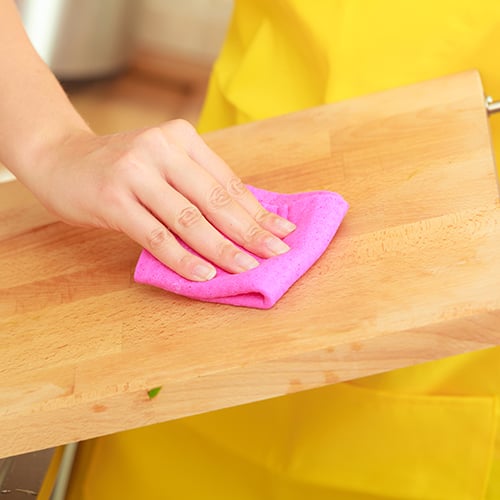
Follow these steps for cleaning a wooden cutting board with soap and water:
- Wash: Hand wash the board immediately after use with water and dish soap.
- Dry: Pat the board dry with a paper towel or clean dishtowel immediately after cleaning.
How to Clean a Wood Cutting Board with Bleach
Effectively kill bacteria on your wooden cutting boards with bleach.
- Mix bleach solution: Create a mixture of 1 tsp. of bleach for every 1 quart of water.
- Apply solution: Pour the mixture over the board and rinse thoroughly with hot water.
How to Clean a Wood Cutting Board with Vinegar
Vinegar is excellent for neutralizing odors and eliminating bacteria. However, due to its lack of potency, using vinegar is not recommended for cutting boards used with raw meat, fish, or poultry.
- Pour: Open your vinegar and pour it over the surface of your board.
- Wipe: Once you've poured the vinegar, wipe down with a clean, wet cloth.
- Dry: Allow the board to dry after it's been cleaned.
Can You Put Wood Cutting Boards in the Dishwasher?
Wood cutting boards are not dishwasher safe. Because moisture absorption can cause splintering and warping of the wood as well as encourage rapid bacteria growth, never submerge your wood cutting board under water or clean it in the dishwasher.
How to Maintain Wood Cutting Boards
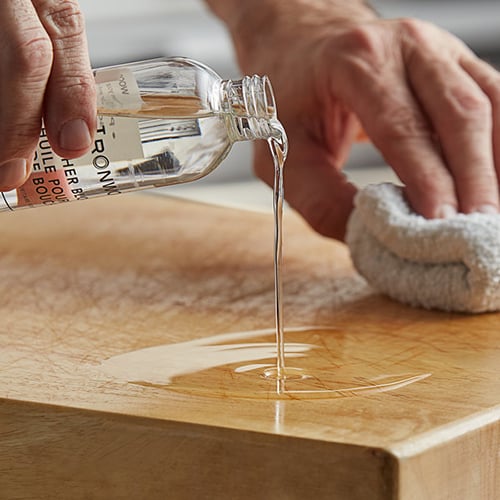
Seasoning your wood cutting board can extend its life and prevent warps and cracks from forming. Depending on how often you use your wooden cutting board, you can season it weekly, bi-weekly, or monthly.
Here’s how to season your wooden cutting board:
- Condition: Wipe food-grade mineral oil or beeswax over your dry board’s exterior.
- Rest: Allow the oil to sit for a few hours.
- Wipe: Use a dry cloth to wipe off excess oil or beeswax.
Never use vegetable or olive oil to season a cutting board because these can become rancid over time.
Back to TopHow to Clean Bamboo Cutting Boards
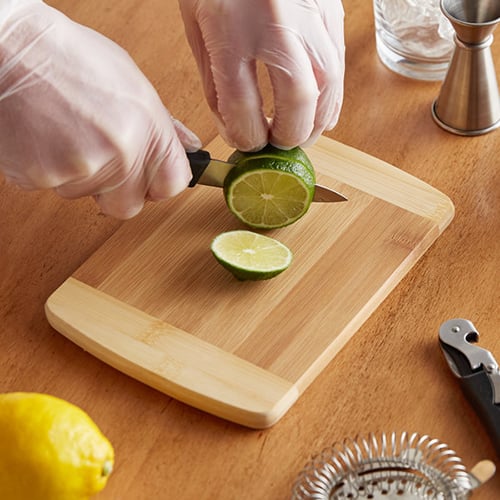
Bamboo cutting boards have a very similar look and feel to wooden cutting boards and can be cared for in the same way. In general, bamboo cutting boards will not crack, warp, or stain as easily as wooden boards because of their higher density. They’re also more resistant to cuts and scars caused by knives than wooden alternatives, which means they’re more resistant to hazardous bacteria growth. Just like wooden cutting boards, you should not soak your bamboo cutting board or put it through the dishwasher.
To clean your bamboo cutting board, follow the steps below:
- Choose a cleaning substance: You may use dish soap, white vinegar, or a dilution of bleach and water to clean your board.
- Add hot water: Combine your chosen cleaning product with hot water and thoroughly scrub the surface of your board.
- Dry: Pat the board dry with a paper towel or clean dishtowel immediately after cleaning.
How to Maintain Bamboo Cutting Boards
The process for maintaining a bamboo cutting board is very similar to that used to maintain a wooden board:
- Condition: Wipe food-grade mineral oil or beeswax over your dry board’s exterior. Never use vegetable or olive oil to season a cutting board because these can become rancid over time.
- Rest: Allow the oil to sit for a few hours.
- Wipe: Wipe off excess oil or beeswax with a dry cloth.
- Freshen up: You can also slice a lemon in half and rub it cut-side down over the board’s surface to freshen up the board between oil or beeswax treatments. The natural acidity of the lemon will help to break down any residue on your cutting board.
Each type of cutting board has unique needs for cleaning and maintenance. Therefore, it is important to know how to treat your cutting board to avoid unsafe levels of bacteria and prevent damage. Use this guide as a reference when cleaning your cutting boards, but if you remain unsure of how to treat your board, consult with the board's manufacturer.



